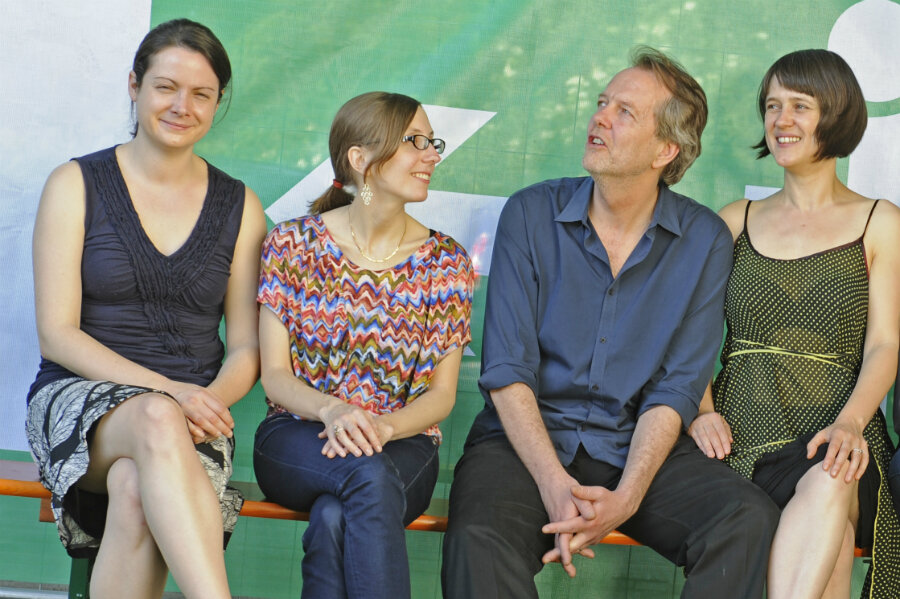Global Soundscapes: Ingrid Laubrock Speaks
This Tuesday, April 24, saxophonist Ingrid Laubrock and her group Anti House 4 return to The Jazz Gallery for two sets. Since arriving in New York, Laubrock has become an integral member of a free-thinking, collaborative community of improvisers, including Mary Halvorson, Kris Davis, Tom Rainey, and many others. Before setting off on a European tour, Laubrock and company will convene at the Gallery to stretch out their musical materials in new directions. We caught up with Laubrock to talk about the development of her recent projects, and what's happened when she's played her music for young children.
The Jazz Gallery: You’ve lived a life with an inspiring amount of globetrotting, from your childhood in Germany, a significant portion of adulthood in London (with lots of virtual traveling to Brazil and Cuba), with your most recent tenure here in New York.
Ingrid Laubrock: I played Cuban music when I was in London but I’ve never been there. I have been to Brazil quite a lot, not only virtually but also physically. Mostly in Sao Paolo and Rio de Janeiro, a little bit to Bahia, as well as some time in Belo Horizonte.
TJG: Do you ever reflect on the differences between these cities and if they have any bearing on your musical processes?
IL: Yes, I definitely think so. I grew up in the countryside so there wasn’t much information around at all. I was really raised around nature and animals. But I think that even that aspect is part of my music, having had lots of space and lots of silence and listening to natural sounds— I’m sure that filters in somewhere. I still have this urge to be in silence, in nature, and I need a fix of that every year. And it’s beyond a vacation. It’s just really wanting to be in a forest, or at the sea, and just having space and relative silence.
I would say London was my probably my formation. I started playing there, I learned so much from so many different types of musicians and from folks, and it has a very dedicated improvising scene, which had some great players that taught me a lot of things. But really, across the board—I learned a lot of things from either musicians my own age, where we explored compositions and music together, or from people who are older and showed me things, or concerts I attended. And New York is a whole other kettle of fish. The pool of musicians is so wide here, everybody does very cool things, and, y’know, it kicks your ass in a way.
Since I’ve been here, what has happened to me is that I write a lot more. I already was going that way in London towards the end. I had a steadier rhythm in London—I just didn’t travel as far much—but here, I’m sometimes super busy, I’m away, on the road. But then there are moments when I really have a chunk of time to fill, which I love to use for writing, and not trying to fill everything up with gigs or sessions like I used to do in London.
TJG: Is there a discrepancy between the soundscapes of New York and London?
IL: Yeah, I think so. Yesterday, I had this concert in SoHo and I was grabbing a bite to eat and sitting outside this bodega by the entrance of the Holland Tunnel. And the light went green and there was immediately this ridiculous concert of honking. It was just so incessant, and went on till the lights changed again and became red. You know, it’s basically a traffic jam and people are frustrated. That kind of stuff is so much more intense here than in London. Everything is louder here. There is so much traffic in London but traffic is slow, and less honking. It’s just not such a thing, more politeness between drivers. Also, I live in a neighborhood where buildings are constantly going up—it’s just mushrooming! And I never lived in a neighborhood like that in London. London has many more two story houses, and most of the houses have a yard. Even if you pay a low rent, it’s just the nature of the town. You have a little buffer between houses, there’s a quiet space in between. And here, it’s just so much denser. So yeah, the sounds are definitely different. There are also huge parks in London, so in general just more green and more silence.
TJG: In 2012, you were named Improviser in Residence in the German city Moers, a post “created to introduce creative music into the city throughout the year,” and led an improvisation ensemble and taught sound workshops in elementary schools. How do children respond to working with sound? And more generally, how does improvised music fit into the city life of Moers?
TJG: As to the second part of the question, Moers has an interesting history with improvised music because the festival that happens that’s been around since 1980—I’ve played it with Kris Davis and Tyshawn Sorey, then with Anti-House, and I also played it last year performing my chamber music pieces with soloists—they just had some kind of jubilee. I know Steve Lacy, George Lewis, and Anthony Braxton all played the early incarnations. For a relatively small town—the smallest city in Germany, actually—so it has all in all one million inhabitants, but it feels really like a small town because it incorporated a lot of villages. It’s on the edge of the Rhine Valley, and the Rhine Valley is sort of a cultural hotspot in Germany. But Moers, just on the other side of the Rhine, is a little quieter, but it has a very interesting history.
The person who led the festival at the time asked me to be the composer-in-residence, and he basically started this post to keep it going throughout the year. So it wasn’t just like, here’s this festival that has nothing to do with the rest of the city, and bye-bye again [laughs]. So it was cool! I had a little house there with a piano and a drum kit, and I could do house concerts. I also had a lot of concerts happening in the town.
Part of the stuff I did were these workshops with small children, elementary school students. And I teamed up with a very hip theater company in that town, and a woman in that company that does theater for children, and brings children to theater. We teamed up and designed this workshop where we tried to make kids play around with sounds rather than notes and music in the traditional sense. We found all of these materials, mostly found things, metal or wood or glass or water, paper, plus other other materials that we brought in. And we broke the kids up into groups and asked them each to explore the sounds that these materials can make, write them down, and give them a number. Each group of kids had to come up with five different sounds and what they came up with was beautiful! They’d take a glass and fill it with water, and put marbles in it, and shake it [laughs]. They came up with much creative things than we could have envisioned because they’re basically only six years old and just playing around with these things.
So then, when they could articulate what those sounds were and when they could show us those sounds, we did a conducted improvisation with them. We used a couple of cues, like “quiet” and “loud”, and “active” and “not so active”, and “stop”, “play.” We made this little orchestra with all these sounds and materials. It was really beautiful, and they loved it. It was playful, and it was also musical. It sounded great—to my ears, of course [laughs].
There still was a discipline about it, but we were just trying to make them aware of sound rather than music as we know it, in the sense of pitches and scales. And it was actually very interesting to see how different groups reacted differently. Like, you could tell that the teachers that were really up for it—their kids were also much freer with it. And there were other teachers, you could tell they were thinking, “Why are we really doing this?” And this translated into the attitude of the kids.
My house was next to the kindergarten, so really young kids, and we did a concert for them with Tom Rainey on drums and Dan Peck on tuba, and me playing. We had two groups come in separately. The first group was so up for it, and they just started dancing. They loved it. They kept trying to boss us around, yelling, play something faster, faster. Just super, super enthusiastic about it. And the second group came in with their hands over their ears—they were scared! Even before they heard the sounds we were going to make. And we have a feeling that the teacher said something to them, that maybe it could be loud, or that it would be strange music. So we had to coax them. We played really quietly, we played to them till they warmed up to us. And then at the end, they did this thing that Germans do when they get drunk in the pub: they hooked arms and started swaying from side to side [laughs].
You figure out ways of making this thing less scary to kids that are scared of it, but the general gist was that young kids are very open-minded.
TJG: What should we expect when Anti-House 4 returns to the Gallery this Tuesday and, more generally, what’s on the horizon for you?
IL: We’re going on a tour in a week’s time. John Hollenbeck has agreed to step in cause Tom Rainey’s already in Europe—both of them are very involved in composition when they’re playing—so I’m very excited to see what different aspects John will bring to it. So on the horizon is this tour, but the project that I’ve been working on all of last year and am mastering next week is these two chamber orchestra pieces that I recorded in December. They involve two conductors, this great new music/classical conductor Eric Wubbels, and will also have Taylor Ho Bynum on improvised conduction. Some of it is specified, some of it is more fluctuating, and they also feature soloists—like, Kris [Davis] and Mary [Halvorson] are both part of it, I’m part of it, Josh Sinton on amplified contrabass clarinet, and Nate Wooley as well. These two pieces are going to be released in the fall on Intakt. This is a completely different side of my writing. There’s a choir involved, too! It delves more into the new music/classical music side of things, which is a very long standing interest and a dream for a long time—both writing and actually recording it. I wrote the first piece in Moers in 2012, and it’s been a slow development since then, so I’m very excited.
Ingrid Laubrock Anti House 4 plays The Jazz Gallery on Tuesday, April 24, 2018. The group features Ms. Laubrock on saxophones, Mary Halvorson on guitar, Kris Davis on piano, and John Hollenbeck on drums. Sets are at 7:30 and 9:30 P.M. $20 general admission ($10 for members), $30 reserved cabaret seating ($20 for members) for each set. Purchase tickets here.

